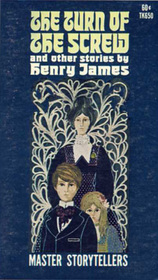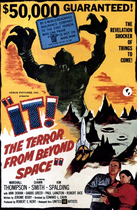Our editor-in-chief Nate Yapp is proud to have contributed to the new book Hidden Horror: A Celebration of 101 Underrated and Overlooked Fright Flicks, edited by Aaron Christensen. Another contributors include Anthony Timpone, B.J. Colangelo, Dave Alexander, Classic-Horror.com's own Robert C. Ring and John W. Bowen. Pick up a copy today from Amazon.com!
Cold Reads: The Turn of the Screw by Henry James
Spooky children have always been favorite stock characters of the horror genre. Starting as early as The Village of the Damned, blossoming in The Exorcist and The Omen, and bringing us to times as recent as the ones that witnessed Orphan, evil-natured children have always sparked our imagination and our worse parental fears. Henry James' novella The Turn of the Screw presents this now cliché story trope in a setting that may or may not be inhabited by the damned, creating an atmosphere of dread and terror. Although at times a bit of a tough read, The Turn of the Screw remains an icon of psychological horror in literature.
An unnamed man attends a Yuletide party at a friend's home where the guests swap terrifying ghost stories. The host later relates to the man in private the transcribed events of a now deceased governess who was employed at the house of Bly. She was charged to watch and care for two children, the niece and nephew of her employer. The governess adores little Flora, but is a bit put off by the premature arrival of the boy Miles, who has just been discharged from school for unexplained reasons. As the governess tries to adjust, she begins seeing mysterious figures appear on the grounds. She soon discovers the people that she has been seeing are the former governess and her roguish lover. But both of them are dead. Despite this the governess can't help but sense that the dark influence of these two shadows from the past are trying to corrupt Miles and Flora by unspeakable means.
James sets up his story in a completely appropriate and almost self-aware manner. The framing story adds to the doubt the reader feels over the validity of the governess's beliefs. Her tale is told at winter party filled with anecdotes of goblins and ghoulies, not unlike the night Mary Shelley spent with her artistic friends. We can almost imagine the host of the party with the wrinkled, yellowed manuscript held before him, peering through his spectacles and relating the account of the haunted governess as the Yule logs crackle and the cold wind howls. This typical atmosphere prepares the reader for a simple campfire story of wandering spooks and lovers lost.
But simple, this is definitely not. James immediately takes away all of our preconceived notions of a ghost story and hides all the ghoulish and sinister elements under a façade of peace and serenity. This is most predominantly seen in the house of Bly itself. Upon the governess' initial arrival she becomes enchanted with the great old house as her carriage rolls up on a fine spring day. The birds are singing in the trees, the sun is shining, and the house maid and darling little Flora wait out in front for her arrival. Here we were anticipating a rickety Gothic mansion, with shutters banging and candle-bearing spirits beckoning from dusty attics. But James is able to create genuine moments of unease within the charming abode and landscape. If anything, The Turn of the Screw is about the hideous things that remain hidden even in the most lit and innocuous of settings.
The governess is an example of this theme as well. Upon examination of her exterior, she seems calm, poised, authoritative, and logical. We are in her mind the entire story; her thoughts are our thoughts. Even as she rationalizes the bizarre events around her and the off-kilter behavior of the children, we are with her 100% of the way, never doubting her judgment. But it's when other characters make the governess, and by extension us, aware of what's really occurring that the truth hits us as hard as it does our female protagonist. The governess insists on seeing these people, but all those around her tell her the contrary. We want to believe in the governess, but at times we're faced with dealing with the very real possibility of her being completely insane. This scares us in a variety of ways. We not only fear for the well-being of the children who may or may not be in the care of a madwoman, but we ourselves are trapped in her clutches, riding out the story with the growing doubts about every word our narrator has to offer.
At times we cannot even be sure if the darling children themselves are completely innocent. When the spirits make their appearances around the house, the governess asserts that the children are aware of their presence but act as if they see nothing. This has two possible implications. It can be gathered that the governess is mad and that she is merely projecting wrongful suspicion upon Flora and Miles who truly see nothing.
But what about that other implication? That of the children hiding a dirty secret, purposefully fueling the governess' paranoia. This is a fear that James instantly realizes we have and plays it out for all it's worth. The element that makes the Creepy Kid so creepy is the corruption of the innocence we see inherent in all children. The thought of our offspring turning on us, their docile and loving behavior now twisted into murderous hatred, is an idea that unsettles us and pokes at the one of the most sensitive areas of our brain. An interesting thesis could be written on how the children, who are at first viewed as angels, are seemingly corrupted into devils and that governess in turn, at one time their protective savior, soon morphs into their potential executioner.
Despite some truly chilling moments (the governess's confrontation with Peter Quint on the staircase being a choice example), The Turn of the Screw can't help but sag a bit at the seams sometimes. James occasionally writes sentences that almost reach the point of unbearable in their length. At times I could feel my eyes straining, desperately seeking out that period like someone hoping to hear a refreshing breath during their vapid friend's Bible-long story. It creates a rough reading experience and takes away from the overall mood of the piece. It is probably best to avoid reading the book at a moderately fast clip (as per my habit) and rather to take it in small, healthy doses. That way the hidden terrors of the novella can take their time in creeping up on you while you give your mind a rest from the visually daunting chapters.
Without a doubt, The Turn of the Screw is a classic of horror literature and rightfully so. It's one of those works that should be read by genre fans at least once during their lifetime, and all subsequent readings fall entirely on the individual's shoulders. Personally the book served me more in the ways of literary analysis than pure, visceral entertainment. But to each their own, pick your poison, and all that rot. One way or the other the book is sure to leave an impression on your mind, whether it's taking a second glance at the figure in the hallway or reconsidering that babysitting job you've just landed.
Note: Starting in October, Cold Reads will be changing to a monthly format on Classic-Horror.com. The column will be posting one literature review every third Wednesday of each month. We hope to have you continue all of your readership and support!









Well, visceral entertainment
Well, visceral entertainment James is not! On the other hand, I wouldn't call the novella a rough reading experience if you know James and therefore know what to expect--i.e., long, loony, circuitous sentences that can leave you slightly dizzy from the multiple levels of perception and meaning and ambiguity going on inside them. (A former professor of mine, Ian Watt, wrote a very famous and lengthy deconstruction of all the levels of meaning in the first, relatively short paragraph of James' novel The Ambassadors.) You read James for those crazy sentences or you don't read him at all. The Turn of the Screw is a beaut, in which all our notions of the characters and their relationships to one another are continually shifting and upended. Governess as protector/tormentor, children as innocent/possessed. In the end it's the uncertainty that's the true source of terror. It has always struck me that the kids here are of a kin with Hester Prynne's child Pearl in The Scarlet Letter--another child who may be possessed, but is written as if she could be, in the end, simply a willful, slightly perverse little kid--as all kids are willfull and slightly perverse. The conversations between the adults and the kids in these books are both completely naturalistic and at the same time, from the POV of the disturbed adults, weird and unsettling.